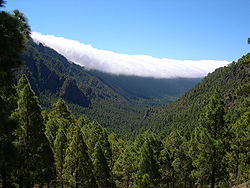Canary Island Pine
|
Pinus canariensis Canary Island pine |
|
|---|---|
 |
|
| Canary Island pines in Caldera de Taburiente, La Palma | |
| Scientific classification | |
| Kingdom: | Plantae |
| Division: | Pinophyta |
| Class: | Pinopsida |
| Order: | Pinales |
| Family: | Pinaceae |
| Genus: | Pinus |
| Subgenus: | Pinus |
| Species: | P. canariensis |
| Binomial name | |
|
Pinus canariensis C.Sm. |
|
Pinus canariensis, the Canary Island pine, is a species of gymnosperm in the coniferous family Pinaceae. It is a large, evergreen tree native and endemic to the outer Canary Islands (Gran Canaria, Tenerife, Hierro and La Palma) in the Atlantic Ocean. It is a subtropical pine and does not tolerate low temperatures or hard frost, surviving temperatures down to about −6 to −10 °C. Within its natural area, it grows under extremely variable rainfall regimes, from less than 300 mm (12 in) to several thousands, mostly due to differences in mist-capturing by the foliage. Under warm conditions, this is one of the most drought-tolerant pines, living even with less than 200 mm (7.9 in) per year. It is the vegetable symbol of the island of La Palma.
The native range has been somewhat reduced due to over-cutting so that only the islands of Tenerife, La Palma and Gran Canaria still have large forests. Really big trees are still rare due to past over-cutting. It is the tallest tree in the Canary Islands.
Pinus canariensis is a large evergreen tree, growing to 30–40 m (98–131 ft) tall and 100–120 cm (39–47 in) trunk diameter (dbh), exceptionally up to 60 m (200 ft) tall and 265 cm (104 in) diameter. The green to yellow-green leaves are needle-like, in bundles of three, 20–30 cm long, with finely toothed margins and often drooping. A characteristic of the species is the occurrence of glaucous (bluish-green) epicormic shoots growing from the lower trunk, but in its natural area this only occurs as a consequence of fire or other damage. This pine is one of the most fire-resistant conifers in the world. The cones are 10–18 cm (3.9–7.1 in) long, 5 cm (2.0 in) wide, glossy chestnut-brown in colour and frequently remaining closed for several years (serotinous cones). Its closest relatives are the Chir Pine (Pinus roxburghii) from the Himalaya, the Mediterranean pines Pinus pinea, Pinus halepensis, Pinus pinaster and Pinus brutia from the eastern Mediterranean.
...
Wikipedia

